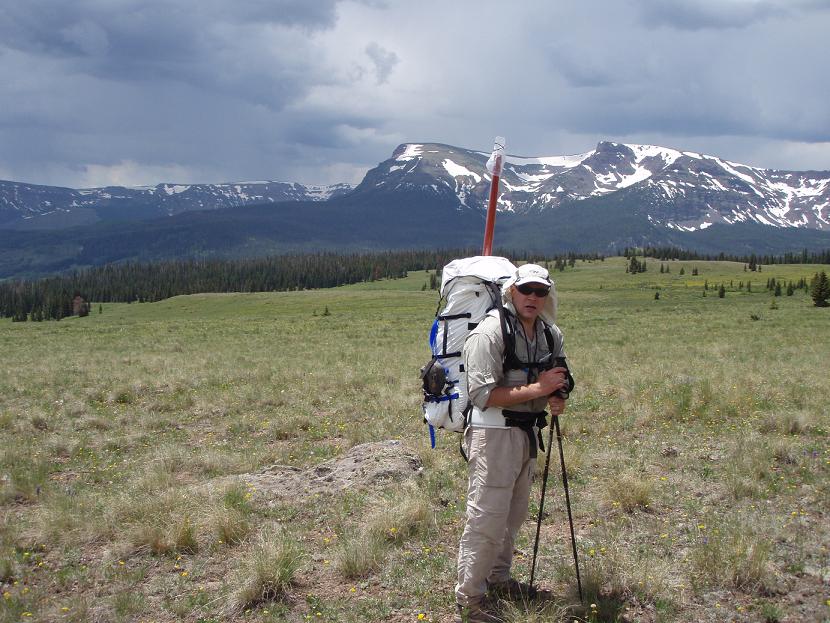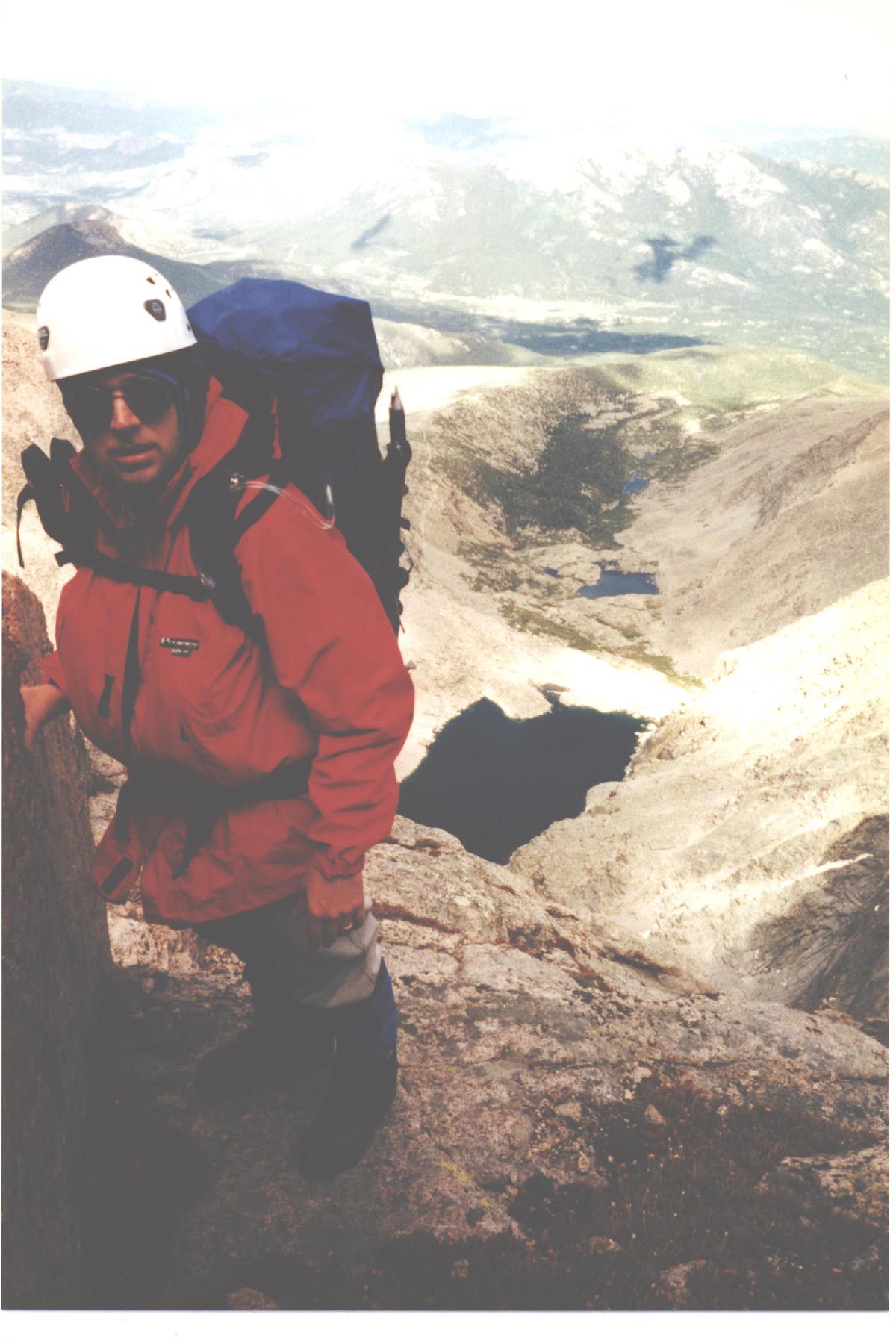|
McHale Spectra SARC (3 pounds, 15 ounces)
This is my newest pack. I wanted something that could handle good size loads for backpacking,
but was lightweight. I spent a lot of time on the phone with Dan McHale, and several days of backpacking with demo packs,
fine tuning the features and sizing of my custom pack.
Finally, I ended up with this custom made Spectra fabric SARC pack. It's streamlined and
simple, but has all of the features that make a McHale pack comfortable to carry, namely the extra wide hip belt, custom sized
frame and suspension, and the independently adjustable shoulder straps and load control straps.
Using a variation of McHale's "bayonet" stays, which are adjustable in length, the pack also
converts from a tall load carrier with high-mounted load control straps, to a shorter climbing pack with greater helmet clearance.
This pack has become my favorite backpacking pack. It is light, but extremely comfortable,
even with heavy loads. The suspension is excellent at transferring the weight to my hips, and it is comfortable to carry
day after day on long hikes. If I could only own a single pack for backpacking, this would be it. I've already used
this pack for hundreds of miles, and numerous trips of a week or more. It has performed flawlessly. I'm looking
forward to putting a lot more mileage on this pack. It's combination of light weight, excellent balance, and carrying
comfort make it the ideal pack for long distances and rough trails.
| McHale SARC in the Flat Tops Wilderness |

|
Kelty Cloud 60 (2 pounds, 10 ounces)
The Kelty Cloud is a lightweight pack made entirely of spectra fabric. It
has a number of modular components, including lightweight aluminum frame stays,foam back pad, three outside pockets, gear
loops, and a choice of padded or unpadded hip belts. Depending on the configuration you choose, you can either strip the pack
down for climbing, or add capacity and comfort for carrying loads. For long climbs carrying medium loads, I configure the
pack with the top lid, the aluminum frame stays, padded belt, compression straps, and a couple of gear loops Total weight
for this configuration is about 2 pounds 10 ounces. Base capacity is 4500 cubic inches (60 liters.) In use, the pack carries
and climbs quite well. It is absolutely essential, however, that you bend the stays to fit your back shape. Without doing
this, the pack doesn't have adequate stability. The frame stays and hipbelt give decent load control that allows comfortable
carry of loads up to about fifty pounds. There is enough lateral flexibility in the frame to allow decent mobility for climbing.
This pack wouldn't be good for strange, gymnastic moves, but is stable enough for straight-forward front pointing on steep
ice. This is the perfect pack for longer routes where you have to carry more than you might want to, and have to climb with
the load on your back. Biggest disadvantage of this pack is the price, which at $550 is pretty steep.

|
| Andinista on the Approach to the Notch Couloir, Long's Peak |
Wild Things Andinista (3 pounds, 9 ounces)
This is a hardcore climbing pack with a unique design. It incorporates two compression zippers, one on each side, which allow the pack volume
to be compressed down to less than half the normal volume 5000+ cubic inches to 1800 cubic inches. This allows you to
carry a bunch of gear in on the approach carrying a big volume pack, and then convert the pack to an alpine day pack for the
climb itself.
The minimalist frame consists of a doubled evazote foam pad which can function
as a bivi pad. There is a long extension sleeve which you can pull up to your waist for bivis. The pack is lightweight.
The idea behind the Andinista is that it is an ultralight pack which can carry
your all of your base camp and climbing junk to a high camp, then compress down into a high performance climbing pack for
the technical climbing when you are carrying only minimal climbing gear. I really liked the concept, but have not used the
pack as much as I might have because I of the compromises inherent in the Andinista's design.
First the negatives: It is this pack's climbing performance that really disappointed
me. The Andinista is long and tall, and when I climb with this pack, I find myself constantly banging the back of my helmeted
head on the top of the pack. There is no readily apparent way to adjust the top of the pack away from your head, because the
soft frame can't be bent back out of the way (but see below.) This problem alone has caused me several episodes of extended
cursing after repeatedly having my helmet knocked down over my eyes. Part of the problem is that the straps that run from
the back of the pack to the top lid are attached too high on the pack body (I guess to keep them out of the way of ice axes
strapped on the back of the pack.) This makes it impossible to crank the top lid down and move it out of the way of your helmeted
head. Lately, I have taken to looping these straps down through the crampon attachment straps, then back up to the top lid.
This allows me to crank the top lid down hard, which pulls it away from my head, increasing headroom dramatically.
The other problem I have with the pack's climbing performance is that the
load lifter straps don't function to take weight off of your shoulders. Even with a relatively light load (10-25 pounds),
I like to take the load off of my shoulders so when I am reaching up or swinging ice tools, the motion of my arms and shoulders
isn't impeded by the pack straps. If you can move your arms and shoulders freely, without being locked into the shoulder straps,
the stability of the pack is improved as well.
The other odd thing about the shoulder straps is that the adjustment slider buckles are located
at the bottom of the strap and oriented upside down compared with other packs. I'm not sure what advantage this is supposed
to confer, but I find it more difficult to adjust the straps, and there is more slippage as well when compared with normal
buckles.
The Andinista doesn't really allow you to lift the load off of the shoulder
straps. This issue is exacerbated with additional weight. When climbing with 20-30 pounds in the pack, I found that I really
missed load lifter straps that would allow me to hip load more of the weight when climbing.
For carrying loads (as opposed to climbing) the Andinista carries reasonably
well considering the minimalistic frame and suspension, provided you pack it carefully. It is adequate for carrying climbing
gear and lightweight bivi or camping gear on the approach. Loads of more than 40-50 pounds are really outside the design of
this pack, and if you have to carry more than this, you need a different pack, or else you are going to have an aching back
and shoulders. One trick I used to make the pack carry heavier loads better on the approach was to buy a sheet of polyethylene
plastic sheeting and cut and trim it to fit in the frame pocket along with the folded evazote pad. This gave the pack better
load carrying characteristics for the hike in, and the plastic frame sheet was easily removable for climbing. I also augmented
the waistbelt with a slightly larger lumbar pad, which also improved carrying comfort.
I'm not a fan of tube-style ice axe holders, so I cut off the ice axe tubes
on the back of the Andinista and replaced them with traditional loops, which work better with my rubber coated bent shaft
ice tools.
I really wanted to like this pack. It is light, versatile, and well made.
The Andinista has an impressive pedigree and has been used on climbs that are way harder than anything I would dream about
climbing by climbers who are way better and more experienced than I will ever be. However, the Andinista is a pack of compromises.
Its performance carrying heavy loads is mediocre, and for hard climbing, I prefer a pack with better head room and with the
ability to shift the load off of my shoulders, two areas where the Andinista comes up short.
However, I still find myself using it occasionally, when I want the simplicity
of a single pack that will carry my stuff to camp and then convert into day-pack size for the climb, where I will
only be carrying very little weight. For this specialized purpose, it functions better than most anything else I've
used.
|

